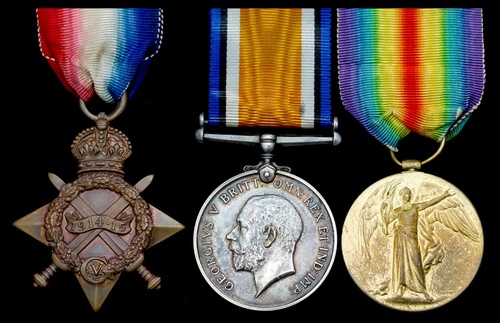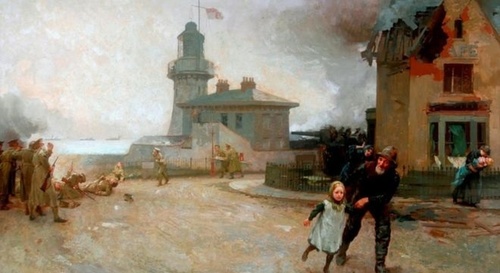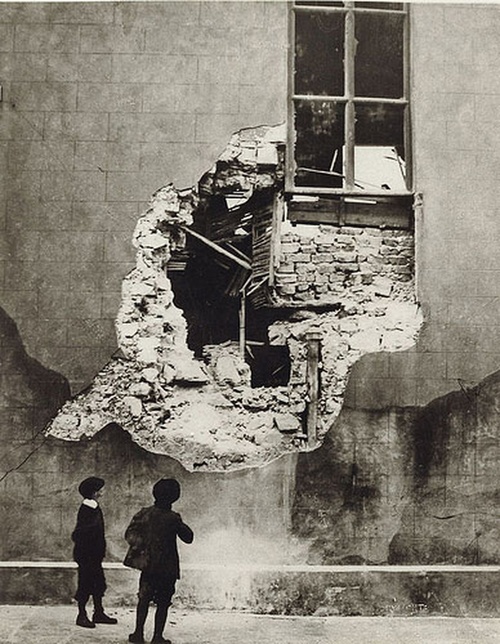Auction: 17002 - Orders, Decorations and Medals
Lot: 170
'The world should know how Hartlepool coped, we're tough you know and what happened that day, we all got back on our feet in no time - good people, tough folk.'
Myra Docherty, a survivor of German bombardment of Hartlepool, speaks her mind.
An emotive Great War campaign group of three awarded to Stoker 1st Class J. Myers, Royal Navy, who was wounded in H.M.S. Hardy on the occasion of the Imperial German Navy's infamous action off Hartlepool on 16 December 1914
On that date, in an act that attracted outrage on an international scale, Admiral Hipper's cruisers indiscriminately bombarded the seaside towns of Hartlepool, Scarborough and Whitby: 137 people were killed, including 78 women and children, and 592 people injured, including 228 women and children, the vast majority of them from Hartlepool
1914-15 Star (S.S. 111735 J. Myers, Sto. 1, R.N.); British War and Victory Medals (S.S. 111735 J. Myers, Sto. 1, R.N.), the second with officially re-impressed naming, very fine or better (3)
John Myers was born in Leeds, Yorkshire on 23 February 1893 and entered the Royal Navy as a Stoker 2nd Class in February 1912. By the outbreak of hostilities, he was borne on the books of Hecla and serving as a Stoker 1st Class in the destroyer H.M.S. Hardy.
A dark day in the history of the Imperial German Navy
In the early morning hours of 16 December 1914, Admiral Hipper's plan to bombard the seaside towns of Hartlepool, Scarborough and Whitby came to fruition, when he divided his cruisers into two forces: The Seydlitz, Blücher and Moltke proceeded to Hartlepool, while the Derfflinger, Von der Tann and Kolberg proceeded to Scarborough. The latter force shelled the town from 8 a.m. until 9.30 a.m. and caused a number of civilian casualties. It then proceeded to Whitby, where the abbey and coast guard station came under fire.
It was at Hartlepool, however, that the most serious damage was inflicted, the indiscriminate broadsides of the Seydlitz, Blücher and Moltke causing civilian casualties of 86 killed and 424 injured. Further evidence of the ferocity of the bombardment may be found in damage inflicted on the town's infrastructure, dozens of buildings - and seven churches - being demolished or damaged: in total more than 1100 shells rained down on the town in just 40 minutes.
Meanwhile, Admiralty intelligence had offered an opportunity for Admiral Warrender to intervene with his battleships and cruisers from Scapa; in addition, Admiral Beatty departed Cromarty with seven destroyers, among them the Hardy. Following a rendezvous at Moray Firth, the combined force made for Dogger Bank to face-off the covering enemy force, an action that resulted in the Hardy taking heavy damage from the cruiser Hamburg with resultant casualties of three killed and 10 wounded: as verified by an endorsement on his service record, the unfortunate Myers was among the latter.
Postscript
Following the outrages committed by the Imperial German Navy off the Yorkshire coast in August 1914, Myers came ashore to Victory II. His final wartime appointment was in the battleship Royal Sovereign, which he joined in April 1916. Demobbed in April 1919, he enrolled in the Royal Fleet Reserve in the same month; sold with copied research and service record.
Subject to 20% VAT on Buyer’s Premium. For more information please view Terms and Conditions for Buyers.
Sold for
£320









